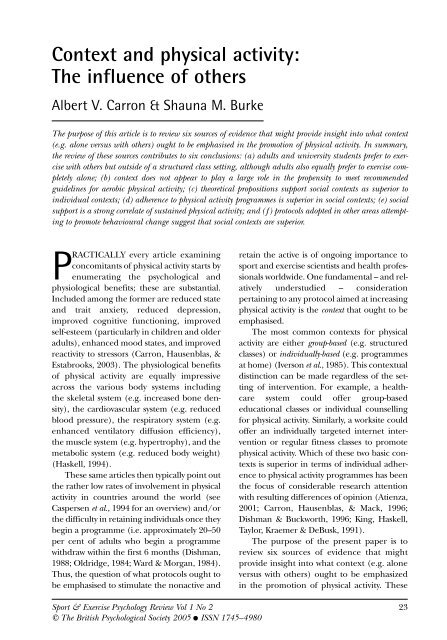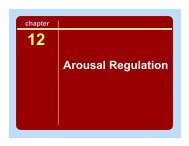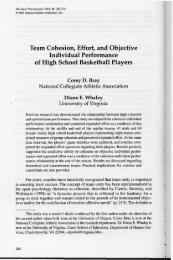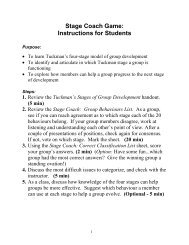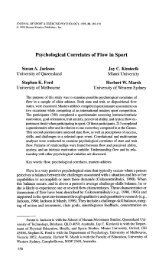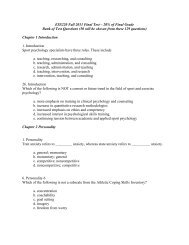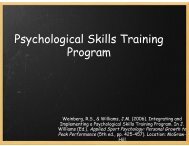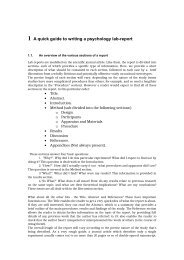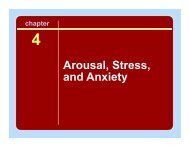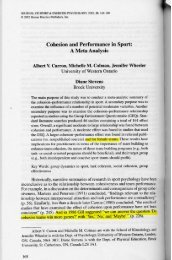Sport and Exercise Psychology Review - Sport Psychology Goes to ...
Sport and Exercise Psychology Review - Sport Psychology Goes to ...
Sport and Exercise Psychology Review - Sport Psychology Goes to ...
You also want an ePaper? Increase the reach of your titles
YUMPU automatically turns print PDFs into web optimized ePapers that Google loves.
Context <strong>and</strong> physical activity:<br />
The influence of others<br />
Albert V. Carron & Shauna M. Burke<br />
The purpose of this article is <strong>to</strong> review six sources of evidence that might provide insight in<strong>to</strong> what context<br />
(e.g. alone versus with others) ought <strong>to</strong> be emphasised in the promotion of physical activity. In summary,<br />
the review of these sources contributes <strong>to</strong> six conclusions: (a) adults <strong>and</strong> university students prefer <strong>to</strong> exercise<br />
with others but outside of a structured class setting, although adults also equally prefer <strong>to</strong> exercise completely<br />
alone; (b) context does not appear <strong>to</strong> play a large role in the propensity <strong>to</strong> meet recommended<br />
guidelines for aerobic physical activity; (c) theoretical propositions support social contexts as superior <strong>to</strong><br />
individual contexts; (d) adherence <strong>to</strong> physical activity programmes is superior in social contexts; (e) social<br />
support is a strong correlate of sustained physical activity; <strong>and</strong> (f) pro<strong>to</strong>cols adopted in other areas attempting<br />
<strong>to</strong> promote behavioural change suggest that social contexts are superior.<br />
PRACTICALLY every article examining<br />
concomitants of physical activity starts by<br />
enumerating the psychological <strong>and</strong><br />
physiological benefits; these are substantial.<br />
Included among the former are reduced state<br />
<strong>and</strong> trait anxiety, reduced depression,<br />
improved cognitive functioning, improved<br />
self-esteem (particularly in children <strong>and</strong> older<br />
adults), enhanced mood states, <strong>and</strong> improved<br />
reactivity <strong>to</strong> stressors (Carron, Hausenblas, &<br />
Estabrooks, 2003). The physiological benefits<br />
of physical activity are equally impressive<br />
across the various body systems including<br />
the skeletal system (e.g. increased bone density),<br />
the cardiovascular system (e.g. reduced<br />
blood pressure), the respira<strong>to</strong>ry system (e.g.<br />
enhanced ventila<strong>to</strong>ry diffusion efficiency),<br />
the muscle system (e.g. hypertrophy), <strong>and</strong> the<br />
metabolic system (e.g. reduced body weight)<br />
(Haskell, 1994).<br />
These same articles then typically point out<br />
the rather low rates of involvement in physical<br />
activity in countries around the world (see<br />
Caspersen et al., 1994 for an overview) <strong>and</strong>/or<br />
the difficulty in retaining individuals once they<br />
begin a programme (i.e. approximately 20–50<br />
per cent of adults who begin a programme<br />
withdraw within the first 6 months (Dishman,<br />
1988; Oldridge, 1984; Ward & Morgan, 1984).<br />
Thus, the question of what pro<strong>to</strong>cols ought <strong>to</strong><br />
be emphasised <strong>to</strong> stimulate the nonactive <strong>and</strong><br />
retain the active is of ongoing importance <strong>to</strong><br />
sport <strong>and</strong> exercise scientists <strong>and</strong> health professionals<br />
worldwide. One fundamental – <strong>and</strong> relatively<br />
understudied – consideration<br />
pertaining <strong>to</strong> any pro<strong>to</strong>col aimed at increasing<br />
physical activity is the context that ought <strong>to</strong> be<br />
emphasised.<br />
The most common contexts for physical<br />
activity are either group-based (e.g. structured<br />
classes) or individually-based (e.g. programmes<br />
at home) (Iverson et al., 1985). This contextual<br />
distinction can be made regardless of the setting<br />
of intervention. For example, a healthcare<br />
system could offer group-based<br />
educational classes or individual counselling<br />
for physical activity. Similarly, a worksite could<br />
offer an individually targeted internet intervention<br />
or regular fitness classes <strong>to</strong> promote<br />
physical activity. Which of these two basic contexts<br />
is superior in terms of individual adherence<br />
<strong>to</strong> physical activity programmes has been<br />
the focus of considerable research attention<br />
with resulting differences of opinion (Atienza,<br />
2001; Carron, Hausenblas, & Mack, 1996;<br />
Dishman & Buckworth, 1996; King, Haskell,<br />
Taylor, Kraemer & DeBusk, 1991).<br />
The purpose of the present paper is <strong>to</strong><br />
review six sources of evidence that might<br />
provide insight in<strong>to</strong> what context (e.g. alone<br />
versus with others) ought <strong>to</strong> be emphasized<br />
in the promotion of physical activity. These<br />
<strong>Sport</strong> & <strong>Exercise</strong> <strong>Psychology</strong> <strong>Review</strong> Vol 1 No 2 23<br />
© The British Psychological Society 2005 ● ISSN 1745–4980


